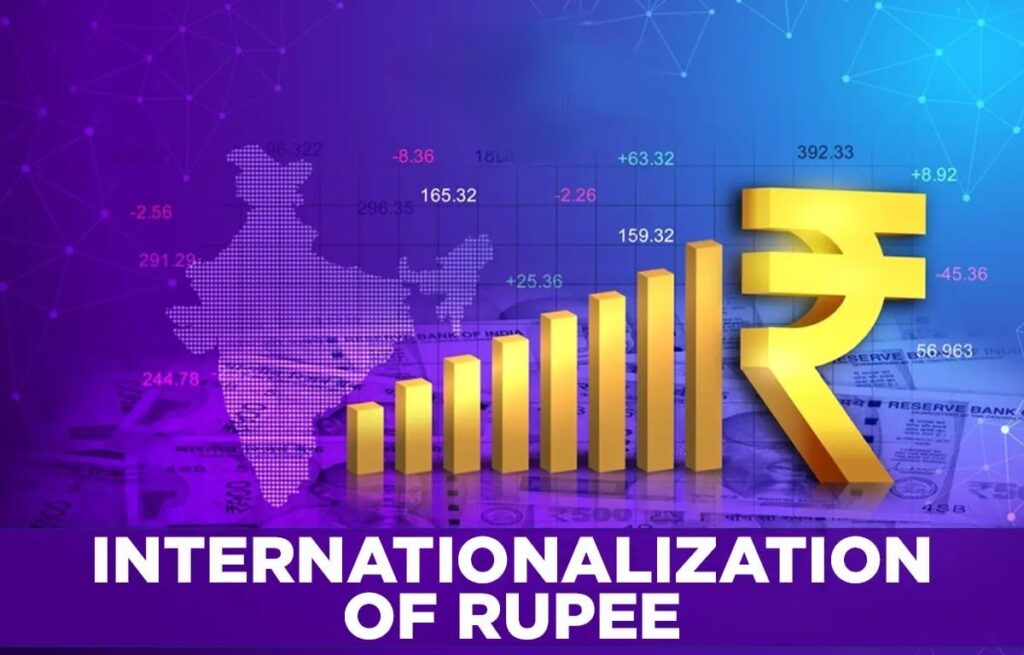The Internationalisation of the Rupee refers to the process of making the Indian Rupee (INR) a globally accepted currency for trade, investment, and as a reserve currency. This means the Rupee would be widely used by foreign entities for cross-border transactions, reducing dependence on the US Dollar or other dominant currencies.
- Internationalization of the Rupee – It is the process of increased cross-border transactions involving the Indian currency.
- It corresponds to trade especially in import-export, current account transactions, and capital account transactions.
- International settlement – This would enable the international settlement of trade in Indian rupees in foreign trades, as opposed to other currency including US dollars.
- The goal of internationalizing the rupee is to make it a more widely accepted currency in international trade and investment.

What are the benefits of internationalizing rupee?
- Mitigate exchange rate risk – Internationalization of the INR can lower transaction costs of cross-border trade and investment operations by mitigating exchange rate risk.
- Reduce risk – Eliminates the risk of exposure to currency volatility faced by Indian businesses.
- Exports becoming competitive – Reducing currency risk can reduce the cost of doing business and can hence help in making exports more competitive in the global market.
- Increased financial integration – Help to integrate the Indian financial system with the global financial system.
- This could lead to increased investment and economic growth.
- Reduced need for foreign exchange reserves – The need to maintain foreign exchange reserves can reduce if a sizeable share of India’s trade can be settled in terms of the domestic currency.
Key Features of Rupee Internationalisation
- Global Acceptance: The Rupee is used for international trade settlements, investments, and held by foreign governments as part of their forex reserves.
- Reduced Currency Risk: It reduces the reliance on the US Dollar, protecting India from currency fluctuations.
- Ease of Cross-Border Transactions: Businesses can settle trade deals in INR instead of using a third-party currency.
- Enhanced Currency Stability: It strengthens the Rupee’s stability in global markets.
Why is India Pushing for Rupee Internationalisation?
- Reducing Dollar Dependency: To lower India’s reliance on the USD for trade and reduce exposure to dollar volatility.
- Boosting Trade with Sanctioned Countries: Using INR for trade with nations under Western sanctions (like Russia) to bypass USD-based restrictions.
- Enhancing Financial Sovereignty: Promoting INR in global transactions increases India’s financial influence.
- Attracting Foreign Investment: Internationalised Rupee may encourage more inflows into Indian assets, boosting the economy.
Steps Taken by India for Rupee Internationalisation
- Bilateral Trade Agreements:
- India has signed Rupee trade agreements with countries like Russia, UAE, and Sri Lanka to conduct trade in INR.
- Special Vostro accounts allow foreign banks to hold INR, facilitating cross-border trade without USD.
- Rupee as an International Payment Currency:
- The Reserve Bank of India (RBI) introduced a framework to settle international trade in INR.
- Indian exporters and importers can invoice and settle in INR with partner nations.
- Allowing External Commercial Borrowings (ECBs) in INR:
- RBI permits foreign firms to issue bonds in INR, increasing the Rupee’s presence in global markets.
- Promotion of INR Bonds:
- Issuance of Masala Bonds (INR-denominated bonds) in international markets.
- Trade with Neighbouring Countries:
- Increased efforts to use INR for trade with countries like Nepal, Bhutan, Bangladesh, and Myanmar.
FAQs
Challenges in Rupee Internationalisation?
- Limited Global Demand: INR still has low demand in international markets compared to USD, EUR, or CNY.
- Volatility of INR: Currency fluctuations make INR less attractive for foreign reserves.
- Lack of Convertibility: The Rupee is not fully convertible on capital accounts, which restricts its free flow in global markets.
- Competition from USD and CNY: The US Dollar dominates global trade, while China’s Yuan is gaining ground.
What is the way forward?
- India should learn from China’s Experience of China’s success in internationalizing the renminbi (RMB) and it also had trade surplus across the world.
- Currency swap agreements and creation of offshore market should be enhanced.
- Considerable thinking and planning would be required to make it function in a manner that does not adversely affect the economy’s fundamentals.
- Allow the settlement of foreign trade in rupees.
- Create special rupee-denominated bonds.
- Promote the use of the rupee in international payments.